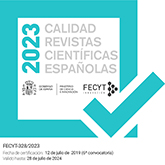Música e imágenes hasta la llegada del cine. (Linterna mágica, armónica de cristal, fantasmagorías y teatro de sombras)
DOI:
https://doi.org/10.3989/anuariomusical.2003.58.77Abstract
The prehistory of talking movies where the coordination of moving images and sound is concerned, comprises a very extensive period of time of thousands of years stretching from the musical illustration of projected shadows as documented in Ancient China, up to practically the very dawn of cinematography, a technological advance unthinkable today more than ever without the contribution that music and sound have made to the so-called seventh art. This study sets out to offer an overall view of the history of continued human interest in capturing movement in sound and vision at the same moment in time, paying particular attention to certain technical achievements of some relevance (the magic lantern, the harmonic crystal, phantasmagories and the theatre of shadows) within the evolution that was to facilitate the birth of the "talkies". A simple introduction to a fascinating and modern world, that, from a purely musicological view is practically nonexistent today (the meagre and marginal bibliography available is the best evidence of that) and which requires new and more detailed studies to be done.
Downloads
Download data is not yet available.
Downloads
Published
2003-12-30
How to Cite
Armell Femenía, M., & Ezquerro Esteban, A. (2003). Música e imágenes hasta la llegada del cine. (Linterna mágica, armónica de cristal, fantasmagorías y teatro de sombras). Anuario Musical, (58), 279–353. https://doi.org/10.3989/anuariomusical.2003.58.77
Issue
Section
Articles
License
Copyright (c) 2003 Consejo Superior de Investigaciones Científicas (CSIC)

This work is licensed under a Creative Commons Attribution 4.0 International License.
© CSIC. Manuscripts published in both the printed and online versions of this Journal are the property of Consejo Superior de Investigaciones Científicas, and quoting this source is a requirement for any partial or full reproduction.All contents of this electronic edition, except where otherwise noted, are distributed under a “Creative Commons Attribution 4.0 International” (CC BY 4.0) License. You may read here the basic information and the legal text of the license. The indication of the CC BY 4.0 License must be expressly stated in this way when necessary.
Self-archiving in repositories, personal webpages or similar, of any version other than the published by the Editor, is not allowed.














